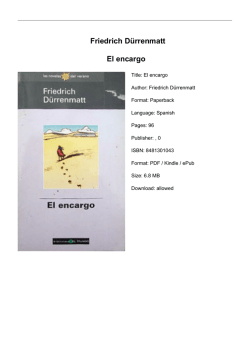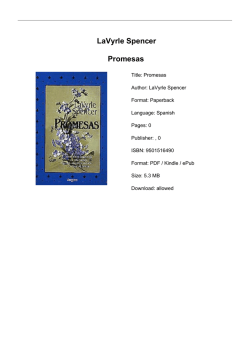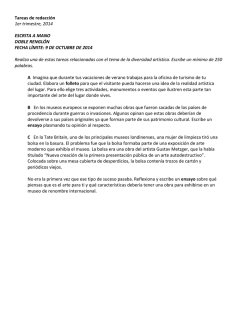
GIMNASIO CAMPESTRE LA SALETTE
GIMNASIO CAMPESTRE LA SALETTE LA SALETTE SCHOOL “Un proyecto educativo para la vida” www.lasalette.edu.co SCIENCE’S REVIEW FOURTH GRADE NAME: __________________________________________________ 1. Match the column A with the column B Column A Column B a) Viviparous ( ) Lay to reproduce b) Oviparous ( ) Develop in an egg inside the mother, And then are born alive. c) Ovoviviparous ( ) Born alive Give an example of an animal according to its reproduction. 2. Complete the definitions with the correct word from the Word Bank Seed chloroplasts cell a) b) c) d) spores viviparous cytoplasm ovoviviparous cones h) The level of organization smaller than a tissue is a _________________ A human is an example of a _____________________ animal. A plant that does not use seeds to reproduce must use _____________ Animals that develop into eggs, but then are born alive are called ____________________. The liquid inside the cell that holds the smaller parts is the __________ ____________________ capture the sun’s energy and make food for the plant. ____________________ contain a small plant inside that looks like the parent plant. ____________________ protect the seeds of plants without flowers. a. b. c. d. 3. Mark the correct answer: The simplest level of organization is: Cell Organ Tissue System e) f) g) a. b. c. d. a. b. c. d. a. b. c. d. Conifers are plants without flowers, because they: Produce pollen and eggs. Produce spores Produce cones Produce fruits Cougars are viviparous animals because: They lay eggs. Their eggs are in the mother’s body. They give birth to live young. They lay eggs and give birth to live young. The nucleus: Protects the cell. Captures the sun’s energy Controls the activities of the cell. Keeps the cell hard. 4. What is a cell? 5. What does a plant cell different from an animal cell? Draw an animal cell and a plant cell. Write their parts. 6. What is a tissue? Draw an example. 7. What is an organ? Draw an example. 8. What is an organ system? Draw an example. 9. Draw the life cycle of a frog. Write the name of each stage. 10. Complete the sentences according to the word bank. Mutualism -- Commensalism – parasitism -- predation -- competition a. _____________________ is when two species compete in order to get the same resource. b. _____________________ is when a specie catches its prey. c. _____________________ This occurs when one organism benefits, but the other is hurt. d. _____________________ in this interaction one organism benefit but the other one seems to be unaffected. e. _____________________ in this interaction both species benefit. GIMNASIO CAMPESTRE LA SALETTE THE SALETTE SCHOOL “Un proyecto educativo para la vida” www.lasalette.edu.co TALLER AREA: HUMANIDADES ASIGNATURA: ESPAÑOLY COMP. LECTORA PERIODO: 1er DOCENTE: AURA M.GIL NOMBRE: _________________________________ FECHA: ________________ GRADO: CUARTO LECTURA COMPRENSIVA Un día estaba Eduardo, el cerdo aventurero, sentado en su pocilga, cuando pasó por allí la ardilla TT con ganas de charla. - Es una pena que aquí en la granja no pase nada. Es puro aburrimiento. Entonces pasó por allí el buey Alberto. Eduardo se puso en pie y dijo: - Estoy planeado ponerme al frente de una expedición… mañana. - ¡Ooooooh! –exclamó la ardilla TT-. ¿A dónde, Eduardo? - ¡Mañana subiré al monte de las hayas! Se produjo una breve pausa y acto seguido dijo Alberto: - Eso lo hace cualquiera. - No por la ruta difícil – repuso Eduardo lleno de Osadía. - ¡Sopla, Eduardo! – Exclamó TT-. ¿Podemos acompañarte todos? - Puede venir el que quiera – respondió Eduardo generosamente. A la mañana siguiente hacía frío y llovía, pero a pesar de ello acudieron todos los animales de la granja a presenciar la salida de la expedición, 1. ¿Quién es el protagonista de la historia? A. B. C. D. El buey Alberto La ardilla TT Eduardo, el cerdo Héctor, el perro. compuesta por el propio Eduardo, la ardilla TT, Héctor, el perro de la granja y el buey Alberto. Empezaron el ascenso, pero una inmensa niebla les envolvía, de tal forma que Héctor y TT vieron a Eduardo desaparecer en la niebla. - Regresemos –dijo Héctor. - Buena idea –convino TT. Y sin dudarlo más, corrieron hacia la granja. Eduardo, desesperado porque no veía a nadie con esa gran niebla se dejó caer en el suelo a esperar que levantase la niebla. Eduardo, que había estado allí sentado todo el día, esperado que la niebla desapareciera, comenzó el camino de descenso al atardecer, ya que no quería que sus amigos pensaran que no había con seguido su objetivo. Cuando llegó a la granja todos le estaban esperando para que les contara su aventura: - Es una pena que no hayáis disfrutado de la magnífica vista de allí arriba. Y el resto de la semana puedo oírse por todas partes a Eduardo hablándoles a sus amigos de su gran expedición al monte de las Hayas. 2. ¿Cuál es su mayor preocupación? A. Subir al monte de las Hayas. B. Que sus amigos le acompañen en la expedición. C. Demostrar que es un aventurero. D. No perderse en el camino. 3. ¿Qué otros animales hay en la granja? 5. Ordena las siguientes frases para resumir la historia: A. B. C. D. A. Eduardo organiza una expedición. B. Eduardo es extravía y tiene que esperar a que levante la niebla. C. A pesar de la lluvia, el frío y la niebla parte la expedición. D. Héctor y TT deciden volver a la granja. Una gallina, un perro y una ardilla. Dos patos, un buey y un conejo. Un buey, una ardilla y un perro. Una vaca, un perro y una ardilla. 4. ¿Cuál de los siguientes grupos de animales salió hacia el monte de las hayas? A. Una ardilla, dos patos y Eduardo. B. Dos patos, una ardilla, Héctor y Eduardo. C. El buey y Eduardo. D. Eduardo, TT, Héctor y el buey. 6. ¿Qué hizo Eduardo en medio de la niebla? A. Volvió a la granja. B. Siguió hasta subir al monte de las Hayas. C. Decidió esperar sentado. D. Subió al monte y esperó allí. 7. ¿Habían estado los animales en el monte de las Hayas anteriormente? ________________________________________________________________ 8. ¿Cuál era la novedad que proponía Eduardo? B. Proponía subir por la ruta difícil. C. Proponía subir un día de niebla. D. Proponía subir y pasar allí la noche. A. Proponía subir sólo. 9. El texto es: A. Una leyenda B. Un cuento C. Una fábula 10. La palabra granja es un sustantivo: A. Propio B. Concreto C. Abstracto 11. Los textos que pertenecen al género lirico son: A. _______________________ B. _______________________ C. _______________________ 12. Los poemas expresan: A. Emociones y sentimientos B. Problemas matemáticos C. Ninguno de los anteriores 13. Cambiar el final del cuento: _____________________________________ _____________________________________ _____________________________________ _____________________________ 14. Escribe una adivinanza _____________________________________ _____________________________________ _____________________________________ _________________________________ 15. Realiza un resumen del libro leído en el primer periodo (de la leyenda que más le gusto). ________________________________________________________________________________ ________________________________________________________________________________ ________________________________________________________________________________ ________________________________________________________________________________ ________________________________________________________________________________ ________________________________________________________________________________ ________________________________________________________________________________ ________________________________________________________________________________ ________________________________________________________________________________ ________________________________________________________________________________ ________________________________________________________________________________ ________________________________________________________________________________ ________________________________________________________________________________ ________________________________________________________________________________ ________________________________________________________________________________ ________________________________________________________________________________ ________________________________________________________________________________ ________________________________________________________________________________ ________________________________________________________________________________ ________________________________________________________________________________ ________________________________________________________________________________ ________________________________________________________________________________ ________________________________________________________________________________ ________________________________________________________________________________ ________________________________________________________________________________ ________________________________________________________________________________ ________________________________________________________________________________ _____________________________________________ 16. Qué enseñanza le dejó la lectura del libro leído en el primer periodo: _______________________________________________________________________________ _______________________________________________________________________________ _______________________________________________________________________________ _______________________________________________________________________ GIMNASIO CAMPESTRE LA SALETTE THE SALETTE SCHOOL “Un proyecto educativo para la vida” www.lasalette.edu.co WORKSHOP SUBJECT: ENGLISH PERIOD: FIRST GRADE: FOURTH NAME: _______________________________ TEACHER: Andrés Felipe Bernal 1. Write three sentences about how the weather is going to be on the weekend. 2. Write a short story where you include 5 of the following words: FLASHLIGHT, PLAN, EMERGENCY, SUPPLIES, EVACUATE, SHELTER, SANDSTORM, BLIZZARD, HURRICANE, TROPICAL STORM, HEAT WAVE, THUNDER 3. Draw a picture of a blizzard and of a tornado. 4. Choose 5 pairs of animals and do comparisons with them using as ___________ as. Use pg. 26 of your textbook as a guide. 5. Do a crossword puzzle using the following words. The hints should have the definitions for the words. PREDATOR, PREY, CAMOUFLAGE, SPECIES, COPYCAT, STRIPES, POISONOUS, FRIGHTEN, HUNT, HIDE Read the following passages and choose the correct options according to the readings. One of my favorite vacation places is Mexico. I really like the weather there because it never gets cold. The people are very nice too. They never laugh at my bad Spanish. The food is really good. Mexico City is a very interesting place to visit. It has some great museums and lots of fascinating old buildings. The hotels are too expensive to stay but there are more affordable options. For example, you can stay at one of the beach resorts like Acapulco. If you are planning to visit Mexico, you should definitely see the Mayan temples near Merida. 6. a. b. c. d. Sam likes warm weather Sam doesn't like warm weather at all Sam hates warm water Sam likes cold weather a. b. c. d. His Spanish is very good He speaks Spanish very well He is Spanish He doesn't speak Spanish very well a. b. c. d. There's a lot to see and do in Mexico There aren't a lof of beautiful places in Mexico Mexico is a dirty place Tourists never come to Mexico a. b. c. d. Hotels are very cheap in Mexico The hotels aren't comfortable there Hotels are all poor in Mexico The hotels in Mexico are pretty expensive 7. 8. 9. 10. What is your favourite place to visit in vacation? Make a drawing and write three reasons. Last summer, we decided to spend our vacation at the beach because the weather was very hot in the mountains. The travel agent said that traveling by bus was the cheapest way, but we went by plane because it was faster. We wanted to have more time to spend at the beach. The weather was beautiful and we had a great time. 11. We decided to go to the beach because ----. a. b. c. d. it was cheaper than going to the mountains the travel agent said that it was the cheapest of the hot weather in the mountains we wanted to spend time at the beach 12. The bus was the ---- way to travel. a. b. c. d. best easiest cheapest slowest 13. Traveling by plane was ---- than by bus. a. b. c. d. more fun cheaper expensive faster 14. We ---- our vacation. a. b. c. d. hated didn't like enjoyed regretted 15. We had very ---- weather during our vacation. a. b. c. d. good hot warm cold 16. What is the best way to travel to vacation? Give three reasons and make a drawing. GIMNASIO CAMPESTRE LA SALETTE THE SALETTE SCHOOL “Un proyecto educativo para la vida” www.lasalette.edu.co WORKSHOP SUBJECT: MATH AND GEOMETRY PERIOD: FIRST GRADE: FOURTH NAME: _______________________________ TEACHER: Andrés Felipe Bernal 1. Solve the following additions. a. 3456 + 2176 c. 20,780 + 9,649 b. 215,673 + 214 + 9,673 d. 193,785 + 2,765 + 9,805 + 864 2. Solve the following subtractions. a. 9,000 – 7,345 c. 65,782 – 2,073 b. 18,007 – 2,983 d. 208,906 – 199,578 3. Write the numbers in words 1,324,778 ______________________________________________________________________________________ 947,890 ___________________________________________________________________________________ 10,677,602 ___________________________________________________________________________________ 4. Write the numbers in standard form. One million, two thousand, nine hundred three ___________________________________ Six hundred thirty-two thousand, two hundred twelve _____________________________ Forty-three million, Eighty-one thousand, ninety-four ________________________________ 5. Compare the numbers using > or < 6. Order the numbers in each column in an increasing order. 7. Order the numbers in each column in a decreasing order. 8. Round to the nearest ten a. 76,867 b. 54,375 c. 8,942 9. Round to the nearest hundred a. 86,467 b. 4,979 c. 28,236 10. Round to the nearest thousand a. 16,907 b. 34,318 c. 18,292 11. Solve the following problems. 1. Two rolls of tape are 3576 cm and 41982 cm long. What is their total length? 2. An egg weighs 1298 grams, a potato weighs 9723 grams more. How much does a potato weigh? 3. An potato weighs 2357 grams, an egg weighs 1962 grams less. How much does an egg weigh? 12. Draw two isosceles triangles and two scalene triangles. 13. Write if the triangle is ISOCELES, SCALENE or EQUILATERAL 14. Finish each drawing in order for them to have reflective symmetry. 15. Color in RED the shapes that have rotational symmetry and in BLACK the shapes that DO NOT have rotational symmetry. GIMNASIO CAMPESTRE LA SALETTE “Un proyecto educativo para la vida” www.lasalette.edu.co SOCIAL STUDIES WORKSHOP NAME: ___________________________________________ DATE: ______________ 4 th GRADE HISTORY Complete the sentences: 1. The phenomenon presented thousands of years ago and that made Earth be extremely cold is called ____________________________. 2. The megafauna was _____________________________________________ _________________________________________________________________ 3. First humans made pictures of _________________________________ in the ___________________ and on ______________ of animals. 4. A clan is ________________________________________________________ 5. A tribe is ________________________________________________________ 6. The first indigenous communities in Colombia that became tribes were __________________________ and _____________________________ 7. San Agustin culture lived in _________________ department. 8. Tierradentro culture lived in __________________________ department 9. Write about the “Parque Arqueologico San Agustin” ________________________________________________________________________________ ________________________________________________________________________________ ________________________________________________________________________________ ________________________________________________________________________________ ____________________________________________________________________________ 10. The culture that lived in Caldas, Risaralda and Quindío was the ____________ 11. Channels for water were built by ___________________ culture 12. Sculptures of San Agustin culture have the shape of _______________and _________________ GEOGRAPHY 13. A region is ______________________________________________________ __________________________________________________________________ __________________________________________________________________ 14. Explain the kinds of regions a._______________________________________________________________________________ ___________________________________________________ b._______________________________________________________________________________ ___________________________________________________ c._______________________________________________________________________________ ___________________________________________________d.____________________________ ________________________________________________________________________________ ______________________ e._______________________________________________________________________________ ___________________________________________________ 15. Write the name of each region 16. Complete the chart about the geographic regions in Colombia. Include information about: location, weather, important products or activities, important places and festivities. DEMOCRACIA 17. ¿Qué es la comunidad? ¿Qué es una comunidad escolar? ________________________________________________________________________________ ________________________________________________________________________________ ________________________________________________________________________________ ________________________________________________________________________________ __________ 18. Explica que es el gobierno escolar y representa en un mapa conceptual como está formado ________________________________________________________________________________ ____________________________________________________ 19. ¿Qué son los derechos? ________________________________________________________________________________ ________________________________________________________________________________ ______________________________________ 20. Escribe y representa con dibujos los derechos de los niños.
© Copyright 2025


